Full text
PDF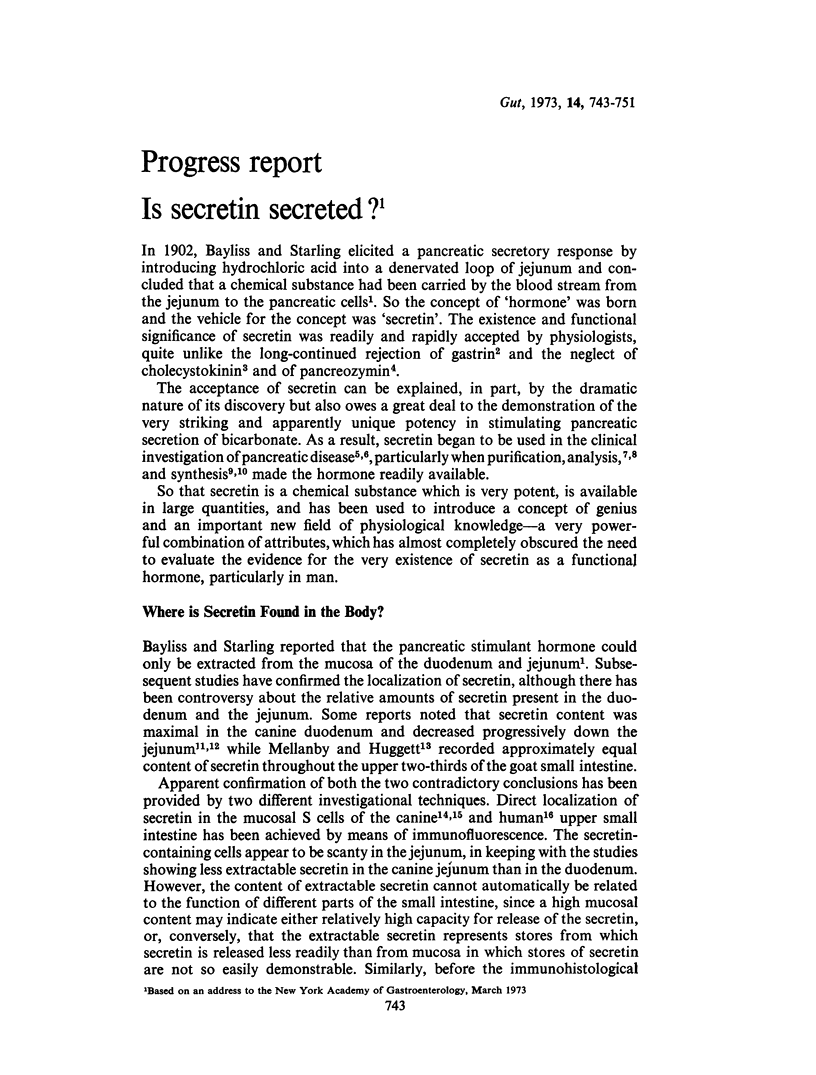
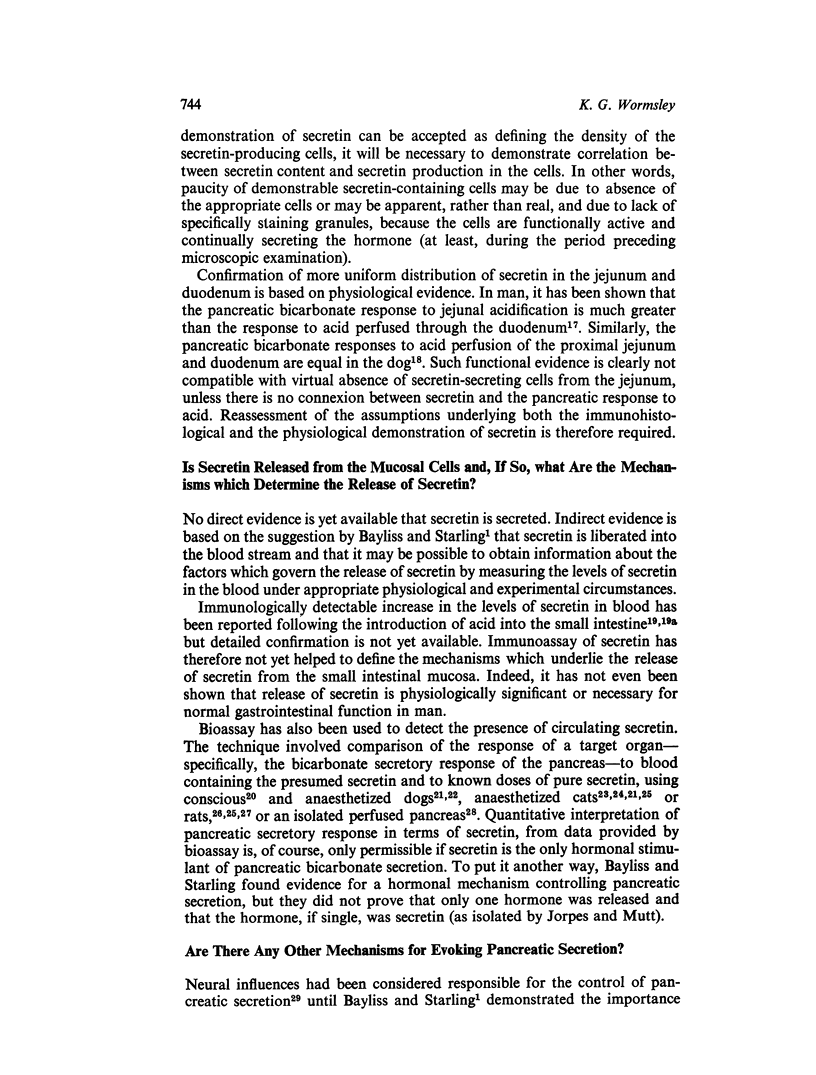
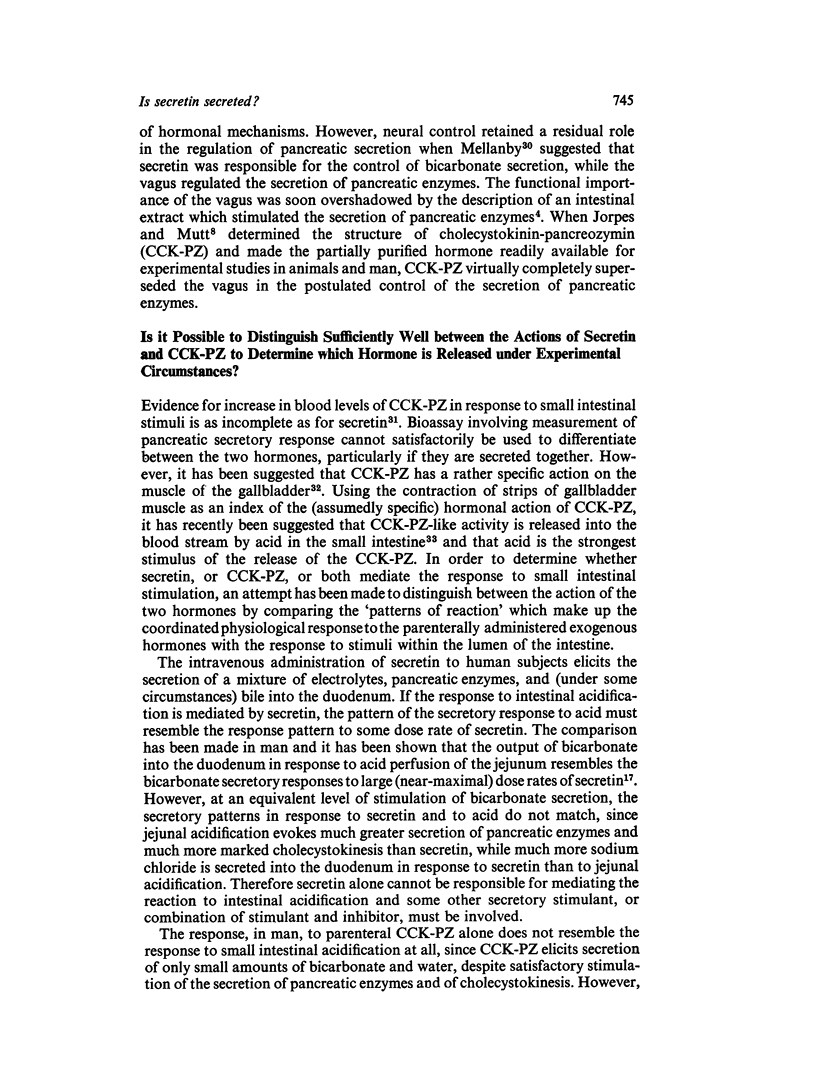
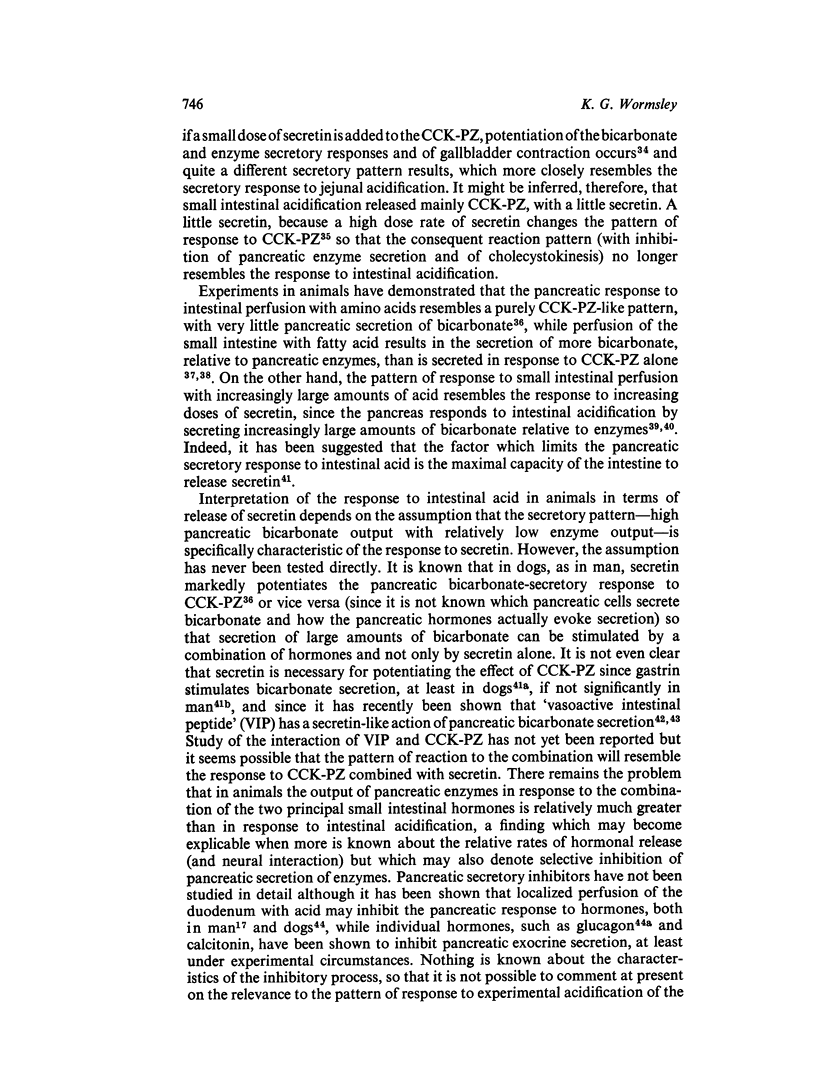
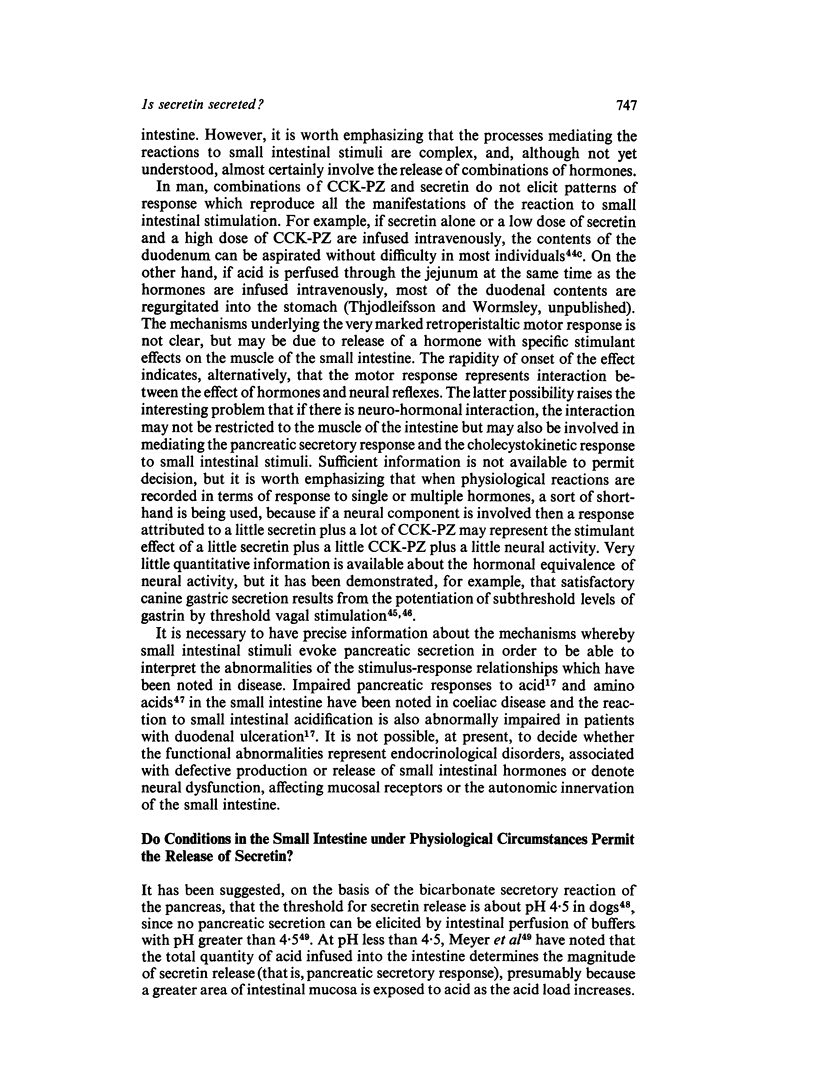
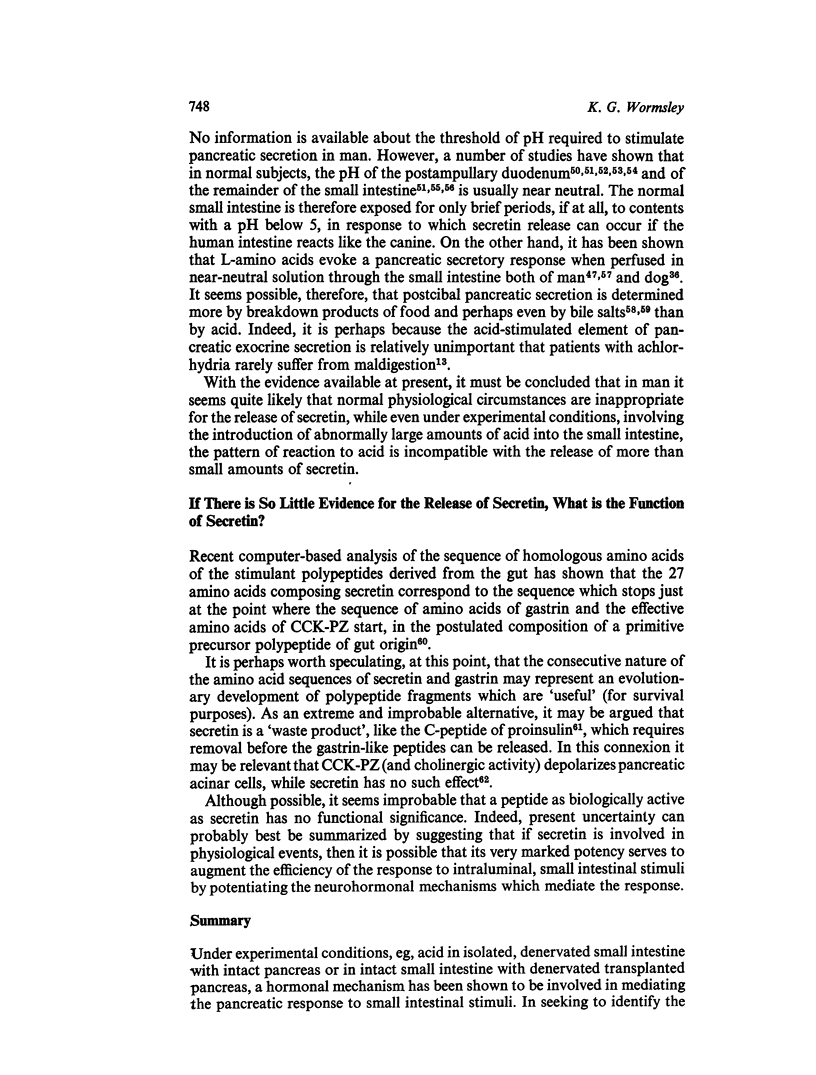
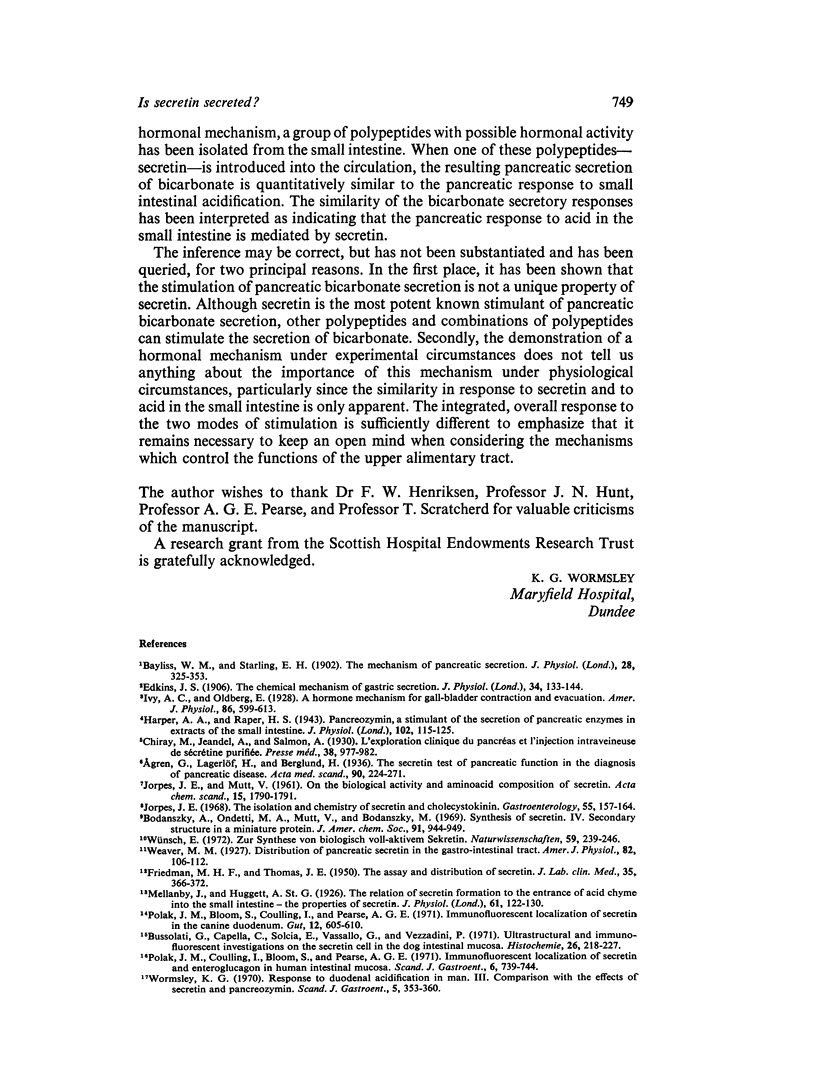
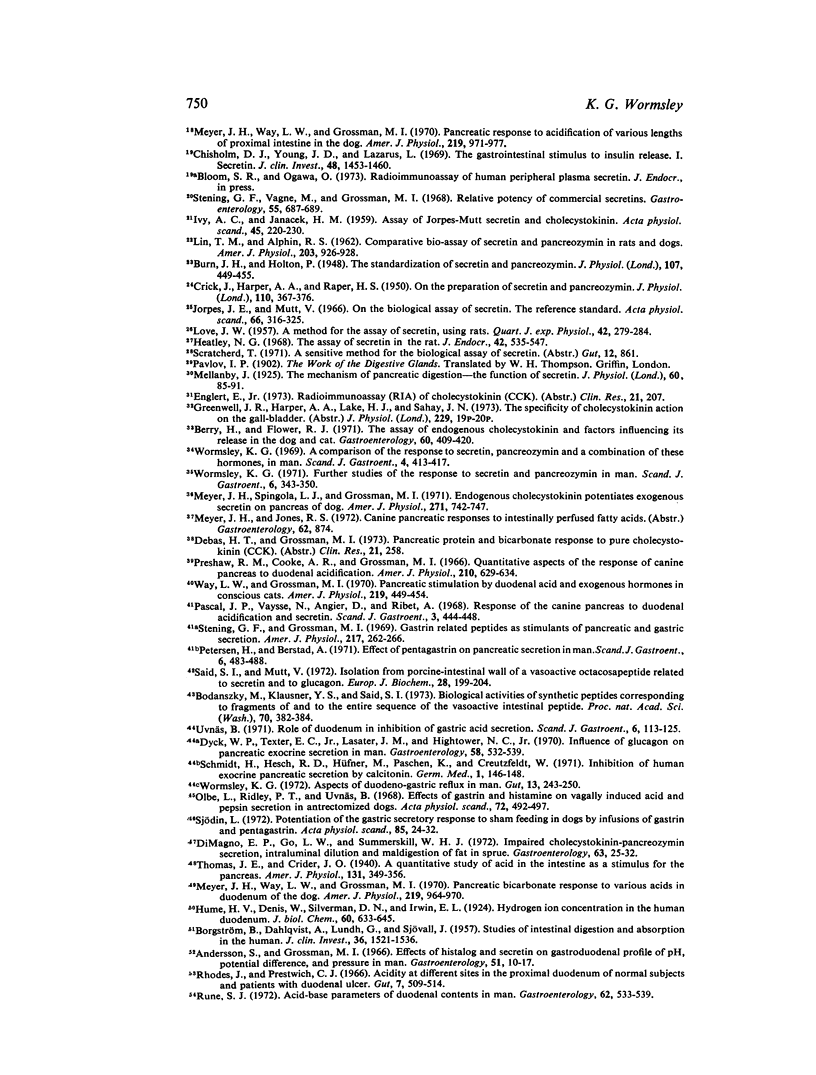
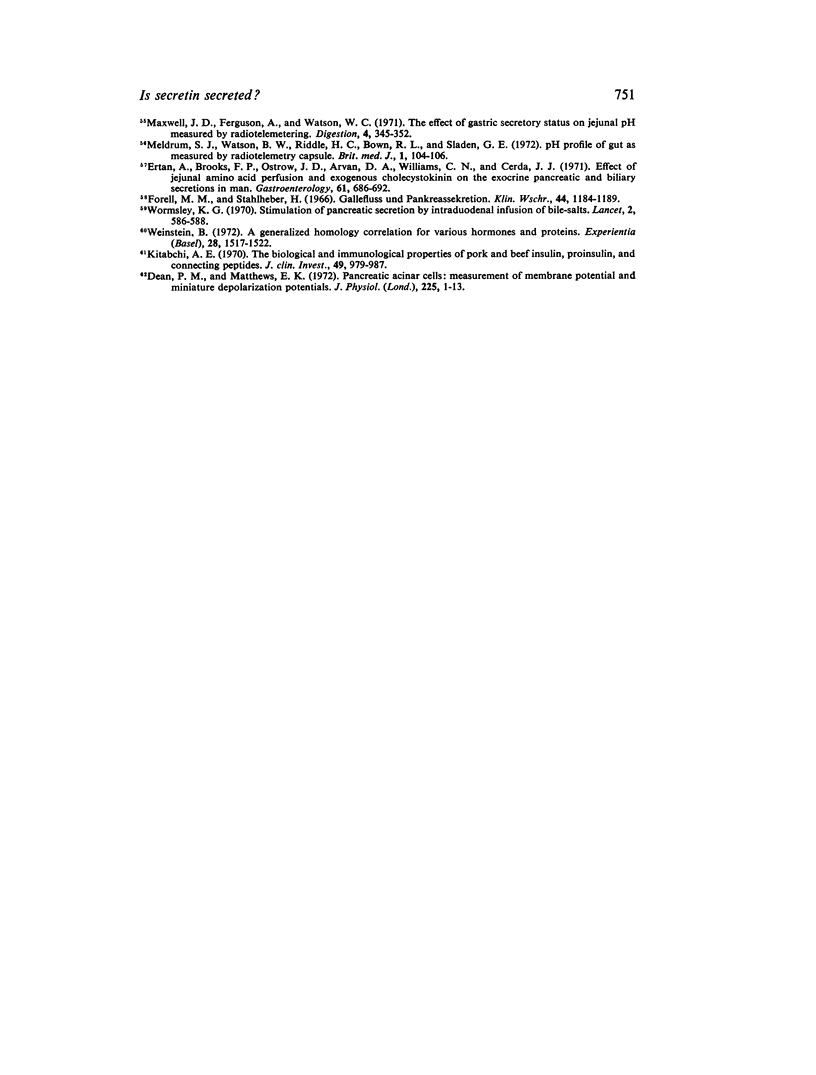
Selected References
These references are in PubMed. This may not be the complete list of references from this article.
- Andersson S., Grossman M. I. Effects of histalog and secretin on gastroduodenal profile of pH, potential difference, and pressure in man. Gastroenterology. 1966 Jul;51(1):10–17. [PubMed] [Google Scholar]
- BORGSTROM B., DAHLQVIST A., LUNDH G., SJOVALL J. Studies of intestinal digestion and absorption in the human. J Clin Invest. 1957 Oct;36(10):1521–1536. doi: 10.1172/JCI103549. [DOI] [PMC free article] [PubMed] [Google Scholar]
- Bayliss W. M., Starling E. H. The mechanism of pancreatic secretion. J Physiol. 1902 Sep 12;28(5):325–353. doi: 10.1113/jphysiol.1902.sp000920. [DOI] [PMC free article] [PubMed] [Google Scholar]
- Berry H., Flower R. J. The assay of endogenous cholecystokinin and factors influencing its release in the dog and cat. Gastroenterology. 1971 Mar;60(3):409–420. [PubMed] [Google Scholar]
- Bodanszky A., Ondetti M. A., Mutt V., Bodanszky M. Synthesis of secretin. IV. Secondary structure in a miniature protein. J Am Chem Soc. 1969 Feb 12;91(4):944–949. doi: 10.1021/ja01032a026. [DOI] [PubMed] [Google Scholar]
- Bodanszky M., Klausner Y. S., Said S. I. Biological activities of synthetic peptides corresponding to fragments of and to the entire sequence of the vasoactive intestinal peptide. Proc Natl Acad Sci U S A. 1973 Feb;70(2):382–384. doi: 10.1073/pnas.70.2.382. [DOI] [PMC free article] [PubMed] [Google Scholar]
- Burn J. H., Holton P. The standardization of secretin and pancreozymin. J Physiol. 1948 Sep 30;107(4):449–455. doi: 10.1113/jphysiol.1948.sp004289. [DOI] [PMC free article] [PubMed] [Google Scholar]
- Bussolati G., Capella C., Solcia E., Vassallo G., Vezzadini P. Ultrastructural and immunofluorescent investigations on the secretin cell in the dog intestinal mucosa. Histochemie. 1971;26(3):218–227. doi: 10.1007/BF00305655. [DOI] [PubMed] [Google Scholar]
- CRICK J., HARPER A. A., RAPER H. S. On the preparation of secretin and pancreozymin. J Physiol. 1949 Dec;110(3-4):367–376. doi: 10.1113/jphysiol.1949.sp004445. [DOI] [PMC free article] [PubMed] [Google Scholar]
- Chisholm D. J., Young J. D., Lazarus L. The gastrointestinal stimulus to insulin release. I. Secretin. J Clin Invest. 1969 Aug;48(8):1453–1460. doi: 10.1172/JCI106111. [DOI] [PMC free article] [PubMed] [Google Scholar]
- Dean P. M., Matthews E. K. Pancreatic acinar cells: measurement of membrane potential and miniature depolarization potentials. J Physiol. 1972 Aug;225(1):1–13. doi: 10.1113/jphysiol.1972.sp009926. [DOI] [PMC free article] [PubMed] [Google Scholar]
- DiMagno E. P., Go W. L., Summerskill W. H. Impaired cholecystokinin-pancreozymin secretion, intraluminal dilution, and maldigestion of fat in sprue. Gastroenterology. 1972 Jul;63(1):25–32. [PubMed] [Google Scholar]
- Dyck W. P., Texter E. C., Jr, Lasater J. M., Hightower N. C., Jr Influence of glucagon on pancreatic exocrine secretion in man. Gastroenterology. 1970 Apr;58(4):532–539. [PubMed] [Google Scholar]
- Edkins J. S. The chemical mechanism of gastric secretion. J Physiol. 1906 Mar 13;34(1-2):133–144. doi: 10.1113/jphysiol.1906.sp001146. [DOI] [PMC free article] [PubMed] [Google Scholar]
- Ertan A., Brooks F. P., Ostrow J. D., Arvan D. A., Williams C. N., Cerda J. J. Effect of jejunal amino acid perfusion and exogenous cholecystokinin on the exocrine pancreatic and biliary secretions in man. Gastroenterology. 1971 Nov;61(5):686–692. [PubMed] [Google Scholar]
- Forell M. M., Stahlheber H. Gallefluss und Pankreassekretion. Klin Wochenschr. 1966 Oct 15;44(20):1184–1189. doi: 10.1007/BF01742096. [DOI] [PubMed] [Google Scholar]
- Greenwell J. R., Harper A. A., Lake H. J., Sahay J. N. The specificity of cholecystokinin action on the gall-bladder. J Physiol. 1973 Feb;229(1):19P–20P. [PubMed] [Google Scholar]
- Harper A. A., Raper H. S. Pancreozymin, a stimulant of the secretion of pancreatic enzymes in extracts of the small intestine. J Physiol. 1943 Jun 30;102(1):115–125. doi: 10.1113/jphysiol.1943.sp004021. [DOI] [PMC free article] [PubMed] [Google Scholar]
- Heatley N. G. The assay of secretin in the rat. J Endocrinol. 1968 Dec;42(4):535–547. doi: 10.1677/joe.0.0420535. [DOI] [PubMed] [Google Scholar]
- IVY A. C., JANECEK H. M. Assay of Jorpes-Mutt secretin and cholecystokinin. Acta Physiol Scand. 1959 Mar 31;45:220–230. doi: 10.1111/j.1748-1716.1959.tb01693.x. [DOI] [PubMed] [Google Scholar]
- Jorpes J. E., Mutt V. On the biological assay of secretin. The reference standard. Acta Physiol Scand. 1966 Mar;66(3):316–325. doi: 10.1111/j.1748-1716.1966.tb03205.x. [DOI] [PubMed] [Google Scholar]
- Jorpes J. E. The isolation and chemistry of secretin and cholecystokinin. Gastroenterology. 1968 Aug;55(2):157–164. [PubMed] [Google Scholar]
- Kitabchi A. E. The biological and immunological properties of pork and beef insulin, proinsulin, and connecting peptides. J Clin Invest. 1970 May;49(5):979–987. doi: 10.1172/JCI106317. [DOI] [PMC free article] [PubMed] [Google Scholar]
- LIN T. M., ALPHIN R. S. Comparative bio-assay of secretin and pancreozymin in rats and dogs. Am J Physiol. 1962 Nov;203:926–928. doi: 10.1152/ajplegacy.1962.203.5.926. [DOI] [PubMed] [Google Scholar]
- LOVE J. W. A method for the assay of secretin, using rats. Q J Exp Physiol Cogn Med Sci. 1957 Jul;42(3):279–284. doi: 10.1113/expphysiol.1957.sp001263. [DOI] [PubMed] [Google Scholar]
- Maxwell J. D., Ferguson A., Watson W. C. The effect of gastric secretory status on jejunal pH measured by radiotelemetering. Digestion. 1971;4(6):345–352. doi: 10.1159/000197139. [DOI] [PubMed] [Google Scholar]
- Mellanby J., Huggett A. S. The relation of secretin formation to the entrance of acid chyme into the small intestine-the properties of secretin. J Physiol. 1926 Mar 18;61(1):122–130. doi: 10.1113/jphysiol.1926.sp002278. [DOI] [PMC free article] [PubMed] [Google Scholar]
- Mellanby J. The mechanism of pancreatic digestion-the function of secretin. J Physiol. 1925 May 21;60(1-2):85–91. doi: 10.1113/jphysiol.1925.sp002223. [DOI] [PMC free article] [PubMed] [Google Scholar]
- Meyer J. H., Spingola J., Grossman M. I. Endogenous cholecystokinin potentiates exogenous secretin on pancreas of dog. Am J Physiol. 1971 Sep;221(3):742–747. doi: 10.1152/ajplegacy.1971.221.3.742. [DOI] [PubMed] [Google Scholar]
- Meyer J. H., Way L. W., Grossman M. I. Pancreatic bicarbonate response to various acids in duodenum of the dog. Am J Physiol. 1970 Oct;219(4):964–970. doi: 10.1152/ajplegacy.1970.219.4.964. [DOI] [PubMed] [Google Scholar]
- Meyer J. H., Way L. W., Grossman M. I. Pancreatic response to acidification of various lengths of proximal intestine in the dog. Am J Physiol. 1970 Oct;219(4):971–977. doi: 10.1152/ajplegacy.1970.219.4.971. [DOI] [PubMed] [Google Scholar]
- Olbe L., Ridley P. T., Uvnäs B. Effects of gastrin and histamine on vagally induced acid and pepsin secretion in antrectomized dogs. Acta Physiol Scand. 1968 Apr;72(4):492–497. doi: 10.1111/j.1748-1716.1968.tb03873.x. [DOI] [PubMed] [Google Scholar]
- Pascal J. P., Vaysse N., Augier D., Ribet A. Response of the canine pancreas to duodenal acidification and secretin. Scand J Gastroenterol. 1968;3(4):444–448. doi: 10.3109/00365526809180143. [DOI] [PubMed] [Google Scholar]
- Petersen H., Berstad A. Effect of pentagastrin on pancreatic secretion in man. Scand J Gastroenterol. 1971;6(6):483–488. doi: 10.3109/00365527109181662. [DOI] [PubMed] [Google Scholar]
- Polak J. M., Bloom S., Coulling I., Pearse A. G. Immunofluorescent localization of secretin in the canine duodenum. Gut. 1971 Aug;12(8):605–610. doi: 10.1136/gut.12.8.605. [DOI] [PMC free article] [PubMed] [Google Scholar]
- Polak J. M., Coulling I., Bloom S., Pearse A. G. Immunofluorescent localization of secretin and enteroglucagon in human intestinal mucosa. Scand J Gastroenterol. 1971;6(8):739–744. doi: 10.3109/00365527109179946. [DOI] [PubMed] [Google Scholar]
- Preshaw R. M., Cooke A. R., Grossman M. I. Quantitative aspects of response of canine pancreas to duodenal acidification. Am J Physiol. 1966 Mar;210(3):629–634. doi: 10.1152/ajplegacy.1966.210.3.629. [DOI] [PubMed] [Google Scholar]
- Rhodes J., Prestwich C. J. Acidity at different sites in the proximal duodenum of normal subjects and patients with duodenal ulcer. Gut. 1966 Oct;7(5):509–514. doi: 10.1136/gut.7.5.509. [DOI] [PMC free article] [PubMed] [Google Scholar]
- Rune S. J. Acid-base parameters of duodenal contents in man. Gastroenterology. 1972 Apr;62(4):533–539. [PubMed] [Google Scholar]
- Said S. I., Mutt V. Isolation from porcine-intestinal wall of a vasoactive octacosapeptide related to secretin and to glucagon. Eur J Biochem. 1972 Jul 13;28(2):199–204. doi: 10.1111/j.1432-1033.1972.tb01903.x. [DOI] [PubMed] [Google Scholar]
- Scratcherd T. A sensitive method for the biological assay of secretin. Gut. 1971 Oct;12(10):861–862. [PubMed] [Google Scholar]
- Sjödin L. Potentiation of the gastric secretory response to sham feeding in dogs by infusions of gastrin and pentagastrin. Acta Physiol Scand. 1972 May;85(1):24–32. doi: 10.1111/j.1748-1716.1972.tb05232.x. [DOI] [PubMed] [Google Scholar]
- Stening G. F., Grossman M. I. Gastrin-related peptides as stimulants of pancreatic and gastric secretion. Am J Physiol. 1969 Jul;217(1):262–266. doi: 10.1152/ajplegacy.1969.217.1.262. [DOI] [PubMed] [Google Scholar]
- Stening G. F., Vagne M., Grossman M. I. Relative potency of commercial secretins. Gastroenterology. 1968 Dec;55(6):687–689. [PubMed] [Google Scholar]
- Uvnäs B. Role of duodenum in inhibition of gastric acid secretion. A brohee lecture given at the 4th World Congress of Gastroenterology in Copenhagen 1970. Scand J Gastroenterol. 1971;6(2):113–125. doi: 10.3109/00365527109180680. [DOI] [PubMed] [Google Scholar]
- Watson B. W., Meldrum S. J., Riddle H. C., Brown R. L., Sladen G. E. pH profile of gut as measured by radiotelemetry capsule. Br Med J. 1972 Apr 8;2(5805):104–106. doi: 10.1136/bmj.2.5805.104. [DOI] [PMC free article] [PubMed] [Google Scholar]
- Way L. W., Grossman M. I. Pancreatic stimulation by duodenal acid and exogenous hormones in conscious cats. Am J Physiol. 1970 Aug;219(2):449–454. doi: 10.1152/ajplegacy.1970.219.2.449. [DOI] [PubMed] [Google Scholar]
- Weinstein B. A generalized homology correlation for various hormones and proteins. Experientia. 1972 Dec 15;28(12):1517–1522. doi: 10.1007/BF01957890. [DOI] [PubMed] [Google Scholar]
- Wormsley K. G. A comparison of the response to secretin, pancreozymin and a combination of these hormones, in man. Scand J Gastroenterol. 1969;4(5):411–417. [PubMed] [Google Scholar]
- Wormsley K. G. Aspects of duodeno-gastric reflux in man. Gut. 1972 Apr;13(4):243–250. doi: 10.1136/gut.13.4.243. [DOI] [PMC free article] [PubMed] [Google Scholar]
- Wormsley K. G. Further studies of the response to secretin and pancreozymin in man. Scand J Gastroenterol. 1971;6(4):343–350. doi: 10.3109/00365527109181131. [DOI] [PubMed] [Google Scholar]
- Wormsley K. G. Response to duodenal acidification in man. 3. Comparison with the effects of secretin and pancreozymin. Scand J Gastroenterol. 1970;5(5):353–360. [PubMed] [Google Scholar]
- Wormsley K. G. Stimulation of pancreatic secretion by intraduodenal infusion of bile-salts. Lancet. 1970 Sep 19;2(7673):586–588. doi: 10.1016/s0140-6736(70)90167-4. [DOI] [PubMed] [Google Scholar]
- Wünsch E. Zur Synthese von biologisch voll-aktivem Sekretin. Naturwissenschaften. 1972 Jun;59(6):239–246. doi: 10.1007/BF00610198. [DOI] [PubMed] [Google Scholar]


